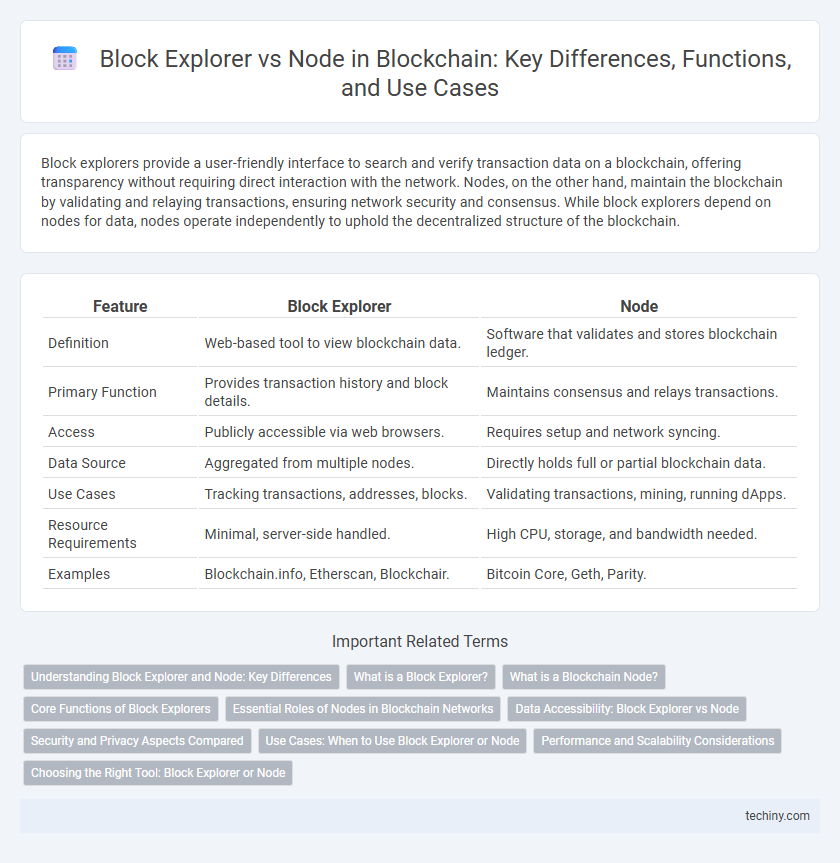Block explorers provide a user-friendly interface to search and verify transaction data on a blockchain, offering transparency without requiring direct interaction with the network. Nodes, on the other hand, maintain the blockchain by validating and relaying transactions, ensuring network security and consensus. While block explorers depend on nodes for data, nodes operate independently to uphold the decentralized structure of the blockchain.
Table of Comparison
| Feature | Block Explorer | Node |
|---|---|---|
| Definition | Web-based tool to view blockchain data. | Software that validates and stores blockchain ledger. |
| Primary Function | Provides transaction history and block details. | Maintains consensus and relays transactions. |
| Access | Publicly accessible via web browsers. | Requires setup and network syncing. |
| Data Source | Aggregated from multiple nodes. | Directly holds full or partial blockchain data. |
| Use Cases | Tracking transactions, addresses, blocks. | Validating transactions, mining, running dApps. |
| Resource Requirements | Minimal, server-side handled. | High CPU, storage, and bandwidth needed. |
| Examples | Blockchain.info, Etherscan, Blockchair. | Bitcoin Core, Geth, Parity. |
Understanding Block Explorer and Node: Key Differences
Block explorers provide a user-friendly interface to browse and verify blockchain transactions, blocks, and addresses without requiring the full blockchain download, making them ideal for quick data access and transparency. Nodes validate, store, and propagate the entire blockchain ledger, ensuring network security and consensus by maintaining a copy of the complete blockchain and validating new transactions and blocks. The primary difference lies in nodes operating as the backbone of blockchain infrastructure, while block explorers serve as analytical tools leveraging node data for enhanced visibility and user interaction.
What is a Block Explorer?
A block explorer is a web-based tool that enables users to search, verify, and analyze blockchain transactions, blocks, and addresses in real-time. It provides a transparent interface to access detailed information stored on the blockchain, such as transaction histories, block confirmations, and wallet balances. Unlike a node, which maintains the full blockchain and validates transactions, a block explorer aggregates and presents this data for easy public access and monitoring.
What is a Blockchain Node?
A blockchain node is a network participant that stores a full or partial copy of the blockchain ledger and validates transactions to maintain consensus across the decentralized network. Nodes play a crucial role in verifying and propagating new blocks, ensuring data integrity and security. Unlike block explorers, which provide user-friendly interfaces to query blockchain data, nodes operate at the protocol level to directly enforce blockchain rules.
Core Functions of Block Explorers
Block explorers serve as essential tools for navigating blockchain networks by providing detailed transaction histories, block data, and address balances in a user-friendly interface. Unlike nodes that validate and relay transactions on the network, block explorers index blockchain data to facilitate quick searches and real-time monitoring of blockchain activity. These core functions enable developers, investors, and users to verify transaction statuses, track asset movements, and analyze network metrics without running full nodes.
Essential Roles of Nodes in Blockchain Networks
Nodes serve as the backbone of blockchain networks by validating transactions and maintaining a decentralized ledger, ensuring security and transparency. Unlike block explorers that provide user-friendly transaction data views, nodes perform critical consensus mechanisms and propagate updates across the network. Their essential roles include verifying blocks, enforcing protocol rules, and enabling peer-to-peer communication to uphold blockchain integrity.
Data Accessibility: Block Explorer vs Node
Block explorers provide user-friendly interfaces for accessing blockchain transaction history, block details, and wallet balances without requiring full node setup. Nodes store the complete blockchain ledger and validate network transactions but demand significant storage, bandwidth, and technical expertise for direct data access. Block explorers optimize data accessibility with real-time indexing and search capabilities, whereas nodes offer raw, trustless data access for developers and advanced users.
Security and Privacy Aspects Compared
Block explorers provide a public interface for viewing blockchain transactions and blocks, enabling transparency but exposing user activity to external observation, which can compromise privacy. Nodes maintain a full copy of the blockchain and validate transactions independently, enhancing security by preventing reliance on third parties but requiring users to manage their own data securely. While block explorers offer convenience, running a personal node ensures greater privacy control and reduces exposure to potential data leaks or censorship.
Use Cases: When to Use Block Explorer or Node
Block explorers are ideal for quick, user-friendly access to transaction histories, address balances, and block data without the need for running a full node. Nodes provide full blockchain validation, essential for developers or businesses requiring complete control, enhanced security, and direct interaction with the network. Use block explorers for lightweight queries and data verification, while nodes suit applications demanding decentralized consensus and transaction broadcasting.
Performance and Scalability Considerations
Block explorers provide user-friendly interfaces for querying blockchain data but rely on backend nodes, impacting their performance based on node responsiveness and network latency. Full nodes maintain the entire blockchain ledger and validate transactions, ensuring high reliability and scalability by handling network consensus and data propagation directly. Scalability in blockchain systems is enhanced by nodes optimizing resource usage, whereas block explorers must balance real-time data retrieval with server-side load management to maintain efficient performance.
Choosing the Right Tool: Block Explorer or Node
Choosing between a block explorer and a node depends on the depth of blockchain interaction required; block explorers provide an intuitive interface for tracking transactions and blocks without maintaining a full copy of the blockchain. Running a node offers direct access to the entire blockchain data, ensuring higher security, privacy, and validation capabilities, essential for developers and validators. Users prioritizing ease of access and simplified data queries often prefer block explorers, while those requiring comprehensive network participation choose nodes.
Block Explorer vs Node Infographic

 techiny.com
techiny.com